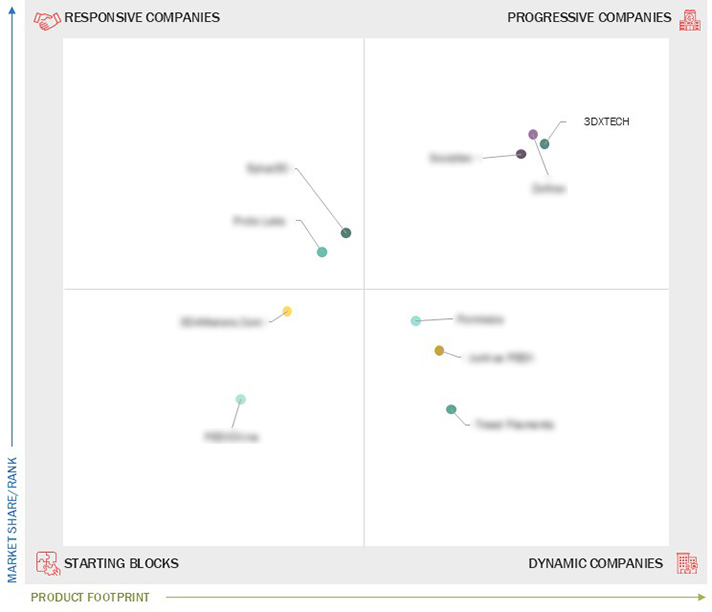Comparing 10 vendors in 3D Printing High Performance Plastic Startups across 0 criteria.
The technology of printing a three-dimensional (3D) object from a digital file using materials such as plastic and other materials is called 3D printing, and the materials used are called 3D printing materials. 3D printing, also known as additive manufacturing, is a transformative and modern approach to industrial production that enables the creation of stronger, lighter parts and systems. In the 3D printing market, high-performance plastics refer to polymer materials with greater strength, purity, stiffness, and resistance to wear and chemicals than the most common 3D printing materials, such as PLA and ABS.
Market Leadership Quadrant
1.1 Study Objectives
1.2 Market Definition
1.3 Study Scope
1.3.1 Markets Covered and Regional Scope
1.3.2 Inclusions and Exclusions
1.3.3 Years Considered
1.4 Currency Considered
1.5 Unit Considered
1.6 Limitations
1.7 Stakeholders
2.1 Introduction
2.2 Market Dynamics
2.2.1 Drivers
2.2.1.1 Increasing applications in medical & healthcare, aerospace & defense, and automotive industries
2.2.1.2 Development of application-specific grades for 3D printing high-performance plastics
2.2.1.3 Government initiatives to support adoption in different industries
2.2.1.4 Rising investments and favorable policies for sustainable solutions
2.2.2 Restraints
2.2.2.1 Environmental concerns regarding disposal of 3D-printed plastic products
2.2.2.2 Skepticism about acceptance of new technologies in emerging economies
2.2.3 Opportunities
2.2.3.1 Increasing demand for bio-based grades of 3D printing high-performance plastics
2.2.3.2 Growing penetration of reinforced 3D printing high-performance plastics in manufacturing functional parts
2.2.4 Challenges
2.2.4.1 High manufacturing cost of commercial grades of 3D printing high-performance plastics
2.2.4.2 Prolonged lead time
2.3 Trends/Disruptions Impacting Customer Business
2.4 Value Chain Analysis
2.5 Ecosystem Analysis
2.6 Investment and Funding Scenario
2.7 Technology Analysis
2.7.1 Key Technologies
2.7.2 Complementary Technologies
2.7.3 Adjacent Technologies
2.8 Patent Analysis
2.9 Trade Analysis
2.10 Porter’s Five Forces Analysis
2.10.1 Threat of New Entrants
2.10.2 Threat of Substitutes
2.10.3 Bargaining Power of Suppliers
2.10.4 Bargaining Power of Buyers
2.10.5 Intensity of Competitive Rivalry
3.1 Introduction
3.2 Key Player Strategies/Right to Win
3.3 Revenue Analysis
3.4 Market Share Analysis
3.5 Company Valuation and Financial Metrics
3.6 Brand/Product Comparison
3.7 Company Evaluation Matrix: Startups/SMEs
3.7.1 Progressive Companies
3.7.2 Responsive Companies
3.7.3 Dynamic Companies
3.7.4 Starting Blocks
3.7.5 Competitive Benchmarking: Startups/SMEs
3.7.5.1 Detailed list of key startups/SMEs
3.7.5.2 Competitive benchmarking of key startups/SMEs
3.8 Competitive Scenario
3.8.1 Product Launches
3.8.2 Deals
3.8.3 Expansions
4.1 Sculpteo
4.1.1 Business overview
4.1.2 Products/Solutions/Services offered
4.1.3 Recent developments
4.2 Zortrax
4.2.1 Business overview
4.2.2 Products/Solutions/Services offered
4.2.3 Recent developments
4.3 3DXTECH
4.3.1 Business overview
4.3.2 Products/Solutions/Services offered
4.3.3 Recent developments
4.4 Eplus3D
4.4.1 Business overview
4.4.2 Products/Solutions/Services offered
4.4.3 Recent developments
4.5 Proto Labs
4.5.1 Business overview
4.5.2 Products/Solutions/Services offered
4.5.3 Recent developments
4.6 Formlabs
4.6.1 Business overview
4.6.2 Products/Solutions/Services offered
4.6.3 Recent developments
4.7 Junhua PEEK
4.7.1 Business overview
4.7.2 Products/Solutions/Services offered
4.7.3 Recent developments
4.8 Treed Filaments
4.8.1 Business overview
4.8.2 Products/Solutions/Services offered
4.8.3 Recent developments
4.9 3D4Makers.com
4.9.1 Business overview
4.9.2 Products/Solutions/Services offered
4.9.3 Recent developments
4.10 PEEKChina
4.10.1 Business overview
4.10.2 Products/Solutions/Services offered
4.10.3 Recent developments


 3D Printing Industry
3D Printing Industry
 Nov 2025
Nov 2025

